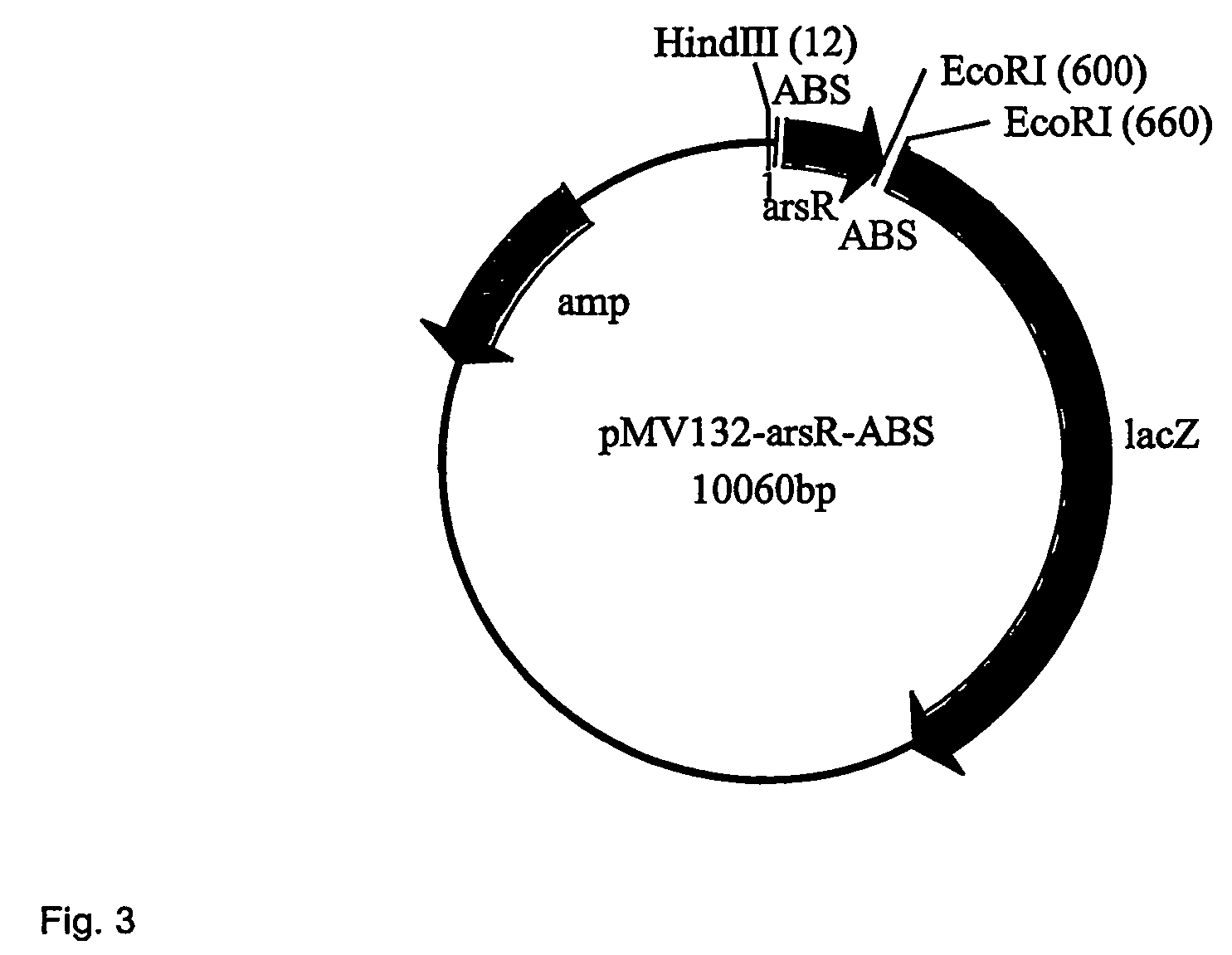Biologically based test system
a test system and biological technology, applied in the direction of instruments, transferases, pollution detectors, etc., can solve the problems of arsenic-free water not being available, chronic poisoning, and threatening the life of millions of peopl
- Summary
- Abstract
- Description
- Claims
- Application Information
AI Technical Summary
Benefits of technology
Problems solved by technology
Method used
Image
Examples
example 1
Construction of a Biosensor for Arsenic Detection Based on Luciferase
[0047]For reasons of detection accuracy and ease of the measurement, a biosensor in E. coli was produced, which would produce light (=bioluminescence) in response to the presence of arsenite. By genetic engineering techniques known in the art, a DNA fragment containing the promoter for arsR (ParsR) and the gene for arsR was isolated, which was in vitro combined with a DNA fragment containing the genes for bacterial luciferase (luxAB). This plasmid, pJAMA8-arsR, was then reintroduced into E. coli strain DH5α (FIG. 4). E. coli DH5α is a laboratory strain and derivative of E. coli K12, classified to the lowest biosafety level and without any known pathogenicity determinants. The response of this E. coli (pJAMA8-arsR) was carefully calibrated and found to be sufficient to detect arsenite in the range below 0.1 μM arsenite (8 μg / l).
example 2
Beta-Galactosidase Based Detection
[0048]The main purpose of producing a whole cell living biosensor for arsenite with the gene for beta-galactosidase as detection system was the potential for a color test kit. The activity of the beta-galactosidase enzyme can be measured in various ways. The easiest one involves the addition of a colorless substrate (X-Gal), which is turned into a blue dye by cleavage with active beta-galactosidase. X-Gal is directly taken up by the bacteria and there is no need to permeabilize or open the cells.
[0049]The original plasmid pBGD23 did not allow the use of X-Gal as a substrate, since the background beta-galactosidase activity in the bacteria was too high. This means that even without any arsenite present, some beta-galactosidase is synthesized in the cells, which cleaves X-Gal and produces the blue color. The reason for this background activity lays in the nature of the ArsR regulatory system. Thus, a plasmid was produced in which the background activi...
example 3
Measuring with Arsenic Biosensors
[0051]In a first instance, both biosensor variants were tested for their capability to detect arsenite in the environmentally relevant concentration range (0-0.5 mg / l), to test the influence of incubation time on the test result, to determine the reproducibility of the biosensor measurement and the influence of disturbing compounds in the water samples. The arsenite concentration in unknown aqueous samples can be inferred by comparing the light signal to that of a standard curve produced with known arsenite concentrations. Inhibitory effects of other chemical compounds present in the sample can be addressed by addition of a known amount of arsenite to the sample and comparing the observed increase in light emission with the light emission expected from the calibration curve.
PUM
| Property | Measurement | Unit |
|---|---|---|
| Volume | aaaaa | aaaaa |
| Volume | aaaaa | aaaaa |
| Volume | aaaaa | aaaaa |
Abstract
Description
Claims
Application Information
 Login to View More
Login to View More - R&D
- Intellectual Property
- Life Sciences
- Materials
- Tech Scout
- Unparalleled Data Quality
- Higher Quality Content
- 60% Fewer Hallucinations
Browse by: Latest US Patents, China's latest patents, Technical Efficacy Thesaurus, Application Domain, Technology Topic, Popular Technical Reports.
© 2025 PatSnap. All rights reserved.Legal|Privacy policy|Modern Slavery Act Transparency Statement|Sitemap|About US| Contact US: help@patsnap.com



